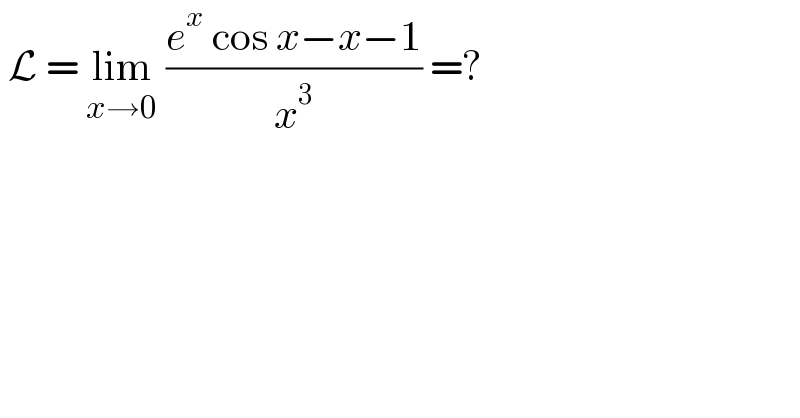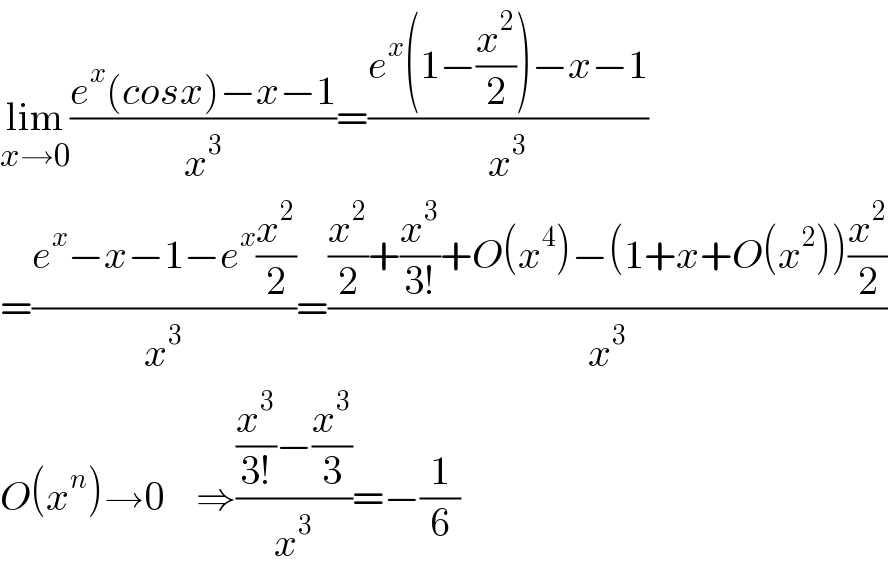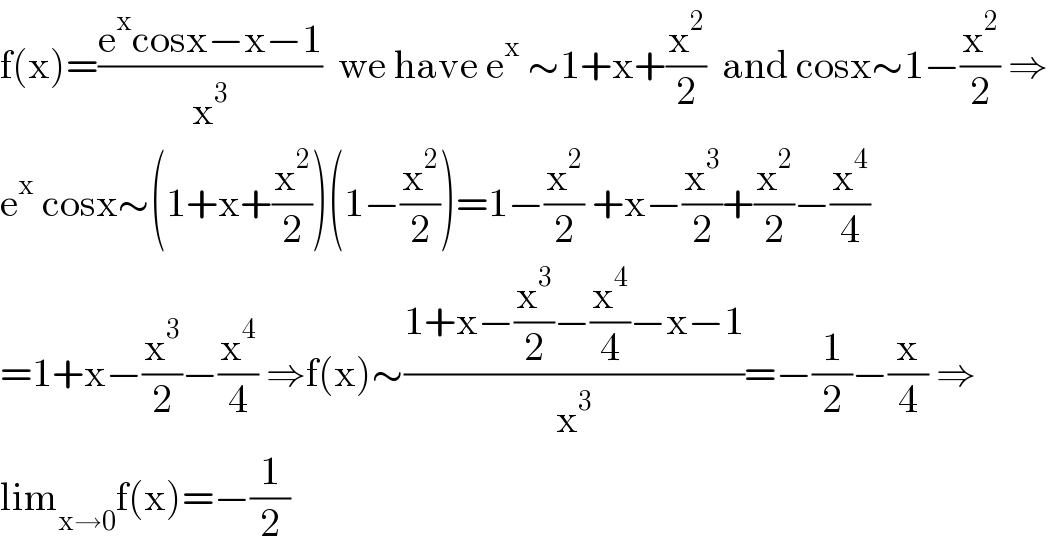Question Number 141900 by iloveisrael last updated on 24/May/21

$$\:\mathcal{L}\:=\:\underset{{x}\rightarrow\mathrm{0}} {\mathrm{lim}}\:\frac{{e}^{{x}} \:\mathrm{cos}\:{x}−{x}−\mathrm{1}}{{x}^{\mathrm{3}} }\:=? \\ $$
Answered by Dwaipayan Shikari last updated on 24/May/21

$$\underset{{x}\rightarrow\mathrm{0}} {\mathrm{lim}}\frac{{e}^{{x}} \left({cosx}\right)−{x}−\mathrm{1}}{{x}^{\mathrm{3}} }=\frac{{e}^{{x}} \left(\mathrm{1}−\frac{{x}^{\mathrm{2}} }{\mathrm{2}}\right)−{x}−\mathrm{1}}{{x}^{\mathrm{3}} } \\ $$$$=\frac{{e}^{{x}} −{x}−\mathrm{1}−{e}^{{x}} \frac{{x}^{\mathrm{2}} }{\mathrm{2}}}{{x}^{\mathrm{3}} }=\frac{\frac{{x}^{\mathrm{2}} }{\mathrm{2}}+\frac{{x}^{\mathrm{3}} }{\mathrm{3}!}+{O}\left({x}^{\mathrm{4}} \right)−\left(\mathrm{1}+{x}+{O}\left({x}^{\mathrm{2}} \right)\right)\frac{{x}^{\mathrm{2}} }{\mathrm{2}}}{{x}^{\mathrm{3}} } \\ $$$${O}\left({x}^{{n}} \right)\rightarrow\mathrm{0}\:\:\:\:\Rightarrow\frac{\frac{{x}^{\mathrm{3}} }{\mathrm{3}!}−\frac{{x}^{\mathrm{3}} }{\mathrm{3}}}{{x}^{\mathrm{3}} }=−\frac{\mathrm{1}}{\mathrm{6}} \\ $$
Answered by mathmax by abdo last updated on 25/May/21

$$\mathrm{f}\left(\mathrm{x}\right)=\frac{\mathrm{e}^{\mathrm{x}} \mathrm{cosx}−\mathrm{x}−\mathrm{1}}{\mathrm{x}^{\mathrm{3}} }\:\:\mathrm{we}\:\mathrm{have}\:\mathrm{e}^{\mathrm{x}} \:\sim\mathrm{1}+\mathrm{x}+\frac{\mathrm{x}^{\mathrm{2}} }{\mathrm{2}}\:\:\mathrm{and}\:\mathrm{cosx}\sim\mathrm{1}−\frac{\mathrm{x}^{\mathrm{2}} }{\mathrm{2}}\:\Rightarrow \\ $$$$\mathrm{e}^{\mathrm{x}} \:\mathrm{cosx}\sim\left(\mathrm{1}+\mathrm{x}+\frac{\mathrm{x}^{\mathrm{2}} }{\mathrm{2}}\right)\left(\mathrm{1}−\frac{\mathrm{x}^{\mathrm{2}} }{\mathrm{2}}\right)=\mathrm{1}−\frac{\mathrm{x}^{\mathrm{2}} }{\mathrm{2}}\:+\mathrm{x}−\frac{\mathrm{x}^{\mathrm{3}} }{\mathrm{2}}+\frac{\mathrm{x}^{\mathrm{2}} }{\mathrm{2}}−\frac{\mathrm{x}^{\mathrm{4}} }{\mathrm{4}} \\ $$$$=\mathrm{1}+\mathrm{x}−\frac{\mathrm{x}^{\mathrm{3}} }{\mathrm{2}}−\frac{\mathrm{x}^{\mathrm{4}} }{\mathrm{4}}\:\Rightarrow\mathrm{f}\left(\mathrm{x}\right)\sim\frac{\mathrm{1}+\mathrm{x}−\frac{\mathrm{x}^{\mathrm{3}} }{\mathrm{2}}−\frac{\mathrm{x}^{\mathrm{4}} }{\mathrm{4}}−\mathrm{x}−\mathrm{1}}{\mathrm{x}^{\mathrm{3}} }=−\frac{\mathrm{1}}{\mathrm{2}}−\frac{\mathrm{x}}{\mathrm{4}}\:\Rightarrow \\ $$$$\mathrm{lim}_{\mathrm{x}\rightarrow\mathrm{0}} \mathrm{f}\left(\mathrm{x}\right)=−\frac{\mathrm{1}}{\mathrm{2}} \\ $$
